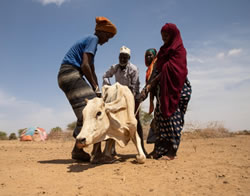Michael Dunford* is calling the world’s attention back to a continuing humanitarian disaster — prolonged drought in the Horn of Africa.
 When I recently visited both the Somali region of Ethiopia and the northern part of Kenya, animal carcasses were a sombre but common part of a landscape that should have been shining with grazing pastures.
When I recently visited both the Somali region of Ethiopia and the northern part of Kenya, animal carcasses were a sombre but common part of a landscape that should have been shining with grazing pastures.
Drought is merciless and the sight of dead animals was just one of many prominent expressions of the current drought’s impact across the Horn of Africa.
In Adadle, in Ethiopia’s Somali region, my World Food Program (WFP) team witnessed a family feeding their cows straw plucked from the thatched roof of their home.
They were among the lucky ones.
Many pastoralists in the area have lost their entire herds to drought. Talking to them and hearing their stories is heart-wrenching.
After three consecutive failed rainy seasons, an estimated 13 million people face severe hunger in Ethiopia, Kenya and Somalia.
Livestock are dying, crops are failing, and livelihoods are at risk due to the worst drought in decades.
As more and more families are forced to move in search of water and pasture, intercommunal conflicts are sure to erupt.
In this region, it is difficult to speak of drought as an isolated event because several interplaying elements contribute to food insecurity.
We tend to talk about the ‘four Cs’ as the key drivers of hunger: Climate, conflict, COVID-19 and rising costs — all of which the drought is exacerbating.
As temperatures across the region keep rising and rainy seasons get shorter, pastures dry up and families move from their homes in search of water and pasture.
I’ve met climate evacuees living in camps for internally displaced people, many for over a year, because they lost all their animals and hence their livelihoods.
They have nothing left. The only way they can meet the basic needs of their families is by coming into the villages where they are now receiving WFP support.
Adding to an already dire situation, Ethiopia and Somalia are affected by ongoing conflicts, putting millions of people at risk of food insecurity.
On top of that, the economic impact of COVID-19 is being felt across the region through low demand for jobs and lower remittances from abroad.
Coupled with rising food and fuel prices and scarcity of commodities, these factors are pushing people to their limits.
Families cannot afford to buy food and are forced to sell the few assets they own to try and feed their families as best they can.
Malnutrition levels are increasing across the region and are particularly worrying among children.
Behind the numbers that define acute malnutrition across the three countries, there are real children whose lives, education and futures hang in the balance if no immediate action is taken.
The WFP has launched an appeal for $US327 million ($A454 million) to respond to the immediate needs of the 4.5 million people most at risk.
Its plan combines emergency humanitarian relief and anticipatory actions to save lives in the short-term and build resilience to change lives in the medium-to-long term.
The WFP needs to scale up life-saving assistance (food and cash distribution) over the coming months to avert a deepening catastrophe.
We also need to bolster the investments that have been made to make communities more robust so that future droughts do not turn into disasters.
We have a long history of building resilience across the region. We have transformed vast swathes of territory into land suitable for agricultural activities.
We have been working on having more people covered by micro-insurance so that when their livestock die or their crops fail, they receive pay-outs.
There is so much that the WFP is doing to cushion the blow, but with three years of insufficient rains, and uncertainty about the upcoming one, the situation is dire.
Working pre-emptively to avoid further impacts on drought-affected populations is imperative to prevent the catastrophic and costly consequences of responding later.
This is a critical moment when we cannot shirk our responsibilities — the world must step up now and support the humanitarian community to avoid a crisis like the one we witnessed in 2011, when 250,000 people died of hunger in Somalia.
Inaction is not an option.
*Michael Dunford is the World Food Program’s Regional Director for Eastern Africa.
This article first appeared on the website of the China Global Television Network.


